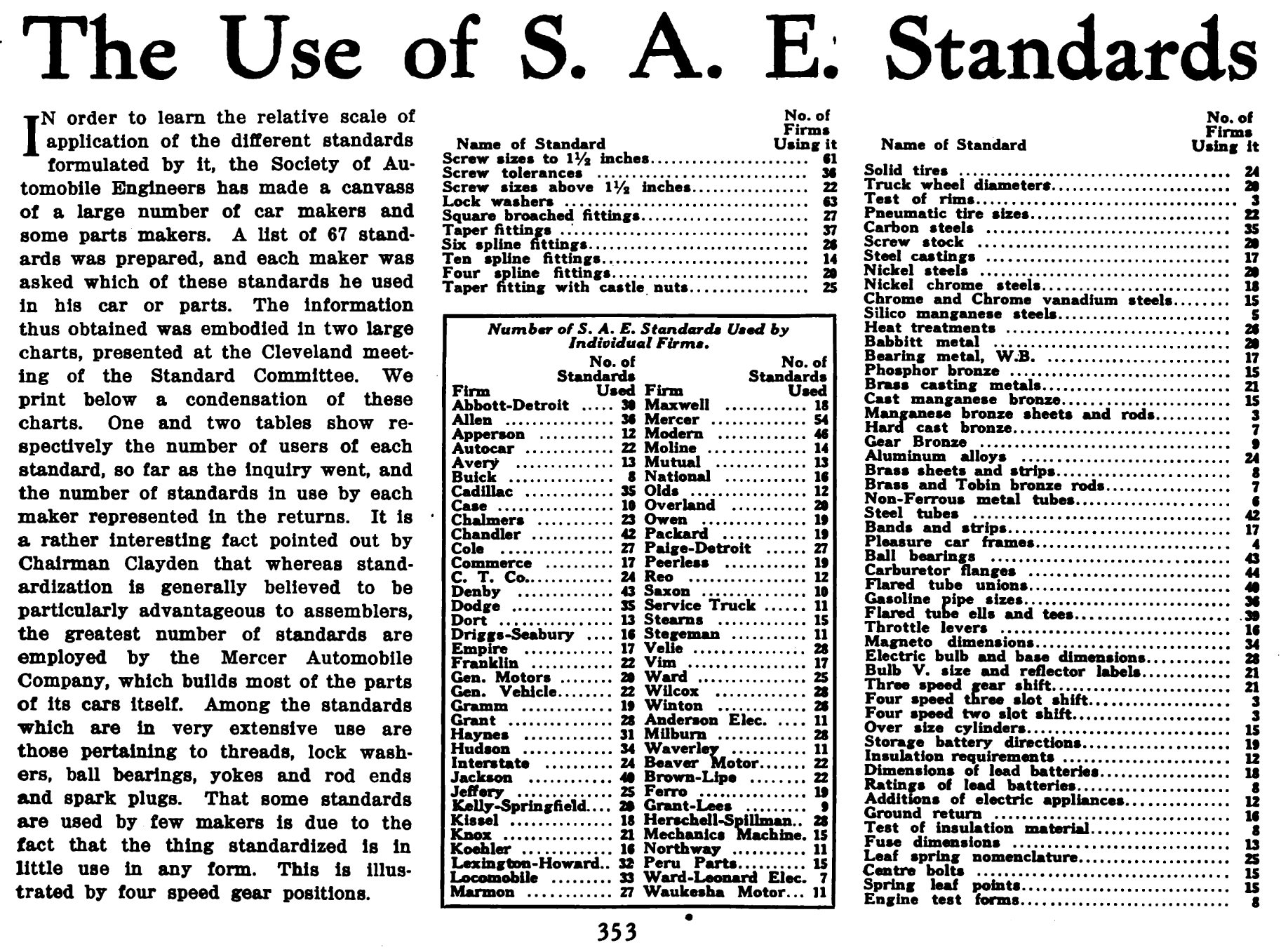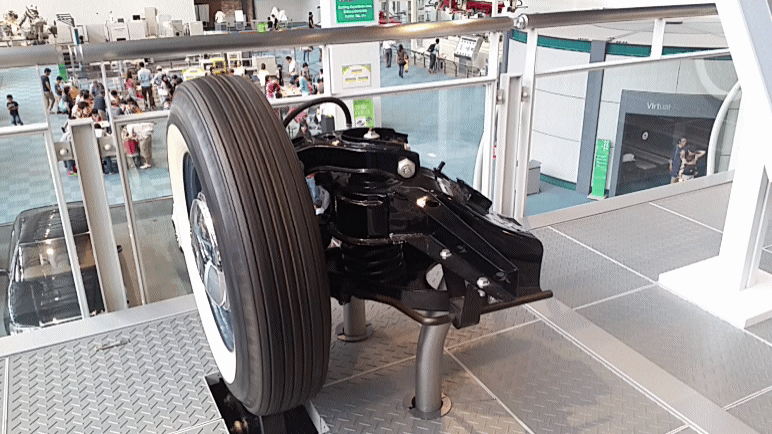|
Antiroll Bar2
An anti-roll bar (roll bar, anti-sway bar, sway bar, stabilizer bar) is an automobile suspension part that helps reduce the body roll of a vehicle during fast cornering or over road irregularities. It links opposite front or rear wheels to a torsion spring using short lever arms for anchors. This increases the suspension's roll stiffness—its resistance to roll in turns. The first stabilizer bar patent was awarded to Canadian inventor Stephen Coleman of Fredericton, New Brunswick on April 22, 1919. Anti-roll bars were unusual on pre-WW2 cars due to the generally much stiffer suspension and acceptance of body roll. From the 1950s on, however, production cars were more commonly fitted with anti-roll bars, especially those vehicles with softer coil spring suspension. Purpose and operation An anti-sway or anti-roll bar is intended to reduce the lateral tilt (roll) of the vehicle on curves, sharp corners, or large bumps. Although there are many variations in design, the ob ... [...More Info...] [...Related Items...] OR: [Wikipedia] [Google] [Baidu] |
Society Of Automotive Engineers
SAE International is a global professional association and standards organization based in Warrendale, Pennsylvania, United States. Formerly the Society of Automotive Engineers, the organization adopted its current name in 2006 to reflect both its international membership and the increased scope of its activities beyond automotive engineering and the automotive industry to include aerospace and other transport industries, as well as commercial vehicles including autonomous vehicles such as self-driving cars, trucks, surface vessels, drones, and related technologies. SAE International has over 138,000 global members. Membership is granted to individuals, rather than companies. Aside from its standardization efforts, SAE International also devotes resources to projects and programs in STEM education, professional certification, and collegiate design competitions. History In the early 1900s there were dozens of automobile manufacturers in the United States, and many more w ... [...More Info...] [...Related Items...] OR: [Wikipedia] [Google] [Baidu] |
Wishbone Suspension
A double wishbone suspension is an independent suspension design for automobiles using two (occasionally parallel) wishbone-shaped arms to locate the wheel. Each wishbone or arm has two mounting points to the chassis and one joint at the knuckle. The shock absorber and coil spring mount to the wishbones to control vertical movement. Double wishbone designs allow the engineer to carefully control the motion of the wheel throughout suspension travel, controlling such parameters as camber angle, caster angle, toe pattern, roll center height, scrub radius, scuff ( mechanical abrasion), and more. Implementation The double-wishbone suspension can also be referred to as "double A-arms", though the arms themselves can be A-shaped or L-shaped. A single wishbone or A-arm can also be used in various other suspension types, such as variations of the MacPherson strut. The upper arm is usually shorter to induce negative camber as the suspension jounces (rises), and often this arrang ... [...More Info...] [...Related Items...] OR: [Wikipedia] [Google] [Baidu] |
Earle S
Earle may refer to: * Earle (given name) * Earle (surname) Places * Earle, Arkansas, a city in Crittenden County, Arkansas, US * Earle, Indiana, an unincorporated town in Vanderburgh County, Indiana, US * Earle, Northumberland, a settlement in Berwick-upon-Tweed, Northumberland, England * Naval Weapons Station Earle, a US Navy base on Sandy Hook Bay in New Jersey See also * * Earl Earl () is a rank of the nobility in the United Kingdom. In modern Britain, an earl is a member of the Peerages in the United Kingdom, peerage, ranking below a marquess and above a viscount. A feminine form of ''earl'' never developed; instead, ... * Earles (other) {{disambiguation, geo ... [...More Info...] [...Related Items...] OR: [Wikipedia] [Google] [Baidu] |
MacPherson Strut
The MacPherson strut is a type of automotive suspension system that uses the top of a telescopic damper as the upper steering pivot. It is widely used in the front suspension of modern vehicles. The name comes from American automotive engineer Earle S. MacPherson, who invented and developed the design. History Earle S. MacPherson was appointed the chief engineer of Chevrolet's Light Car project in 1945. He was tasked with developing a new, smaller car for the immediate post-war market, an effort that led to the Chevrolet Cadet. The Cadet was poised to be a groundbreaking vehicle, and the three prototypes that had been built by 1946 displayed a wide range of innovations. One of these was a revolutionary new independent suspension system that featured what is now known as a MacPherson strut. The Cadet was slated to be the first production vehicle with MacPherson struts, but the project was cancelled in 1947 and never saw commercial production. This was in large part due to GM's ... [...More Info...] [...Related Items...] OR: [Wikipedia] [Google] [Baidu] |
Super GT
Super GT (stylized as SUPER GT) is a sports car racing series that began in 1993. Launched as the , generally referred to as the All Japan Grand Touring Car Championship (JGTC), the series was renamed to Super GT in 2005. It is the top level of sports car racing in Japan. The series is sanctioned by the Japan Automobile Federation (JAF) and run by the GT Association (GTA). Autobacs Seven, Autobacs has been the title sponsor of the series and its predecessor since 1998. History The JGTC years (1993–2004) The JGTC (Japanese Grand Touring Championship) was established in 1993 by the Japan Automobile Federation (JAF) via its subsidiary company the GTA (GT Association), replacing the defunct All Japan Sports Prototype Championship for Group C cars and the Japanese Touring Car Championship for Group A touring cars, which instead would adopt the supertouring formula. Seeking to prevent the spiraling budgets and one-team/make domination of both series, JGTC imposed strict limits on ... [...More Info...] [...Related Items...] OR: [Wikipedia] [Google] [Baidu] |
Auto Racing
Auto racing (also known as car racing, motor racing, or automobile racing) is a motorsport involving the racing of automobiles for competition. In North America, the term is commonly used to describe all forms of automobile sport including non-racing disciplines. Auto racing has existed since the invention of the automobile. Races of various types were organized, with the first recorded as early as 1867. Many of the earliest events were effectively Classic trials, reliability trials, aimed at proving these new machines were a practical mode of transport, but soon became an important way for automobile makers to demonstrate their machines. By the 1930s, specialist racing cars had developed. There are now numerous different categories, each with different rules and regulations. History The first prearranged match race of two self-powered road vehicles over a prescribed route occurred at 4:30 A.M. on August 30, 1867, between Ashton-under-Lyne and Old Trafford, England, a di ... [...More Info...] [...Related Items...] OR: [Wikipedia] [Google] [Baidu] |
Antiroll Bar2
An anti-roll bar (roll bar, anti-sway bar, sway bar, stabilizer bar) is an automobile suspension part that helps reduce the body roll of a vehicle during fast cornering or over road irregularities. It links opposite front or rear wheels to a torsion spring using short lever arms for anchors. This increases the suspension's roll stiffness—its resistance to roll in turns. The first stabilizer bar patent was awarded to Canadian inventor Stephen Coleman of Fredericton, New Brunswick on April 22, 1919. Anti-roll bars were unusual on pre-WW2 cars due to the generally much stiffer suspension and acceptance of body roll. From the 1950s on, however, production cars were more commonly fitted with anti-roll bars, especially those vehicles with softer coil spring suspension. Purpose and operation An anti-sway or anti-roll bar is intended to reduce the lateral tilt (roll) of the vehicle on curves, sharp corners, or large bumps. Although there are many variations in design, the ob ... [...More Info...] [...Related Items...] OR: [Wikipedia] [Google] [Baidu] |
Understeer
Understeer and oversteer are vehicle dynamics terms used to describe the sensitivity of the vehicle to changes in steering angle associated with changes in lateral acceleration. This sensitivity is defined for a level road for a given steady state operating condition by the Society of Automotive Engineers (SAE) in document J670SAE International Surface Vehicle Recommended Practice, "Vehicle Dynamics Terminology", SAE Standard J670, Rev. 2008-01-24 and by the International Organization for Standardization The International Organization for Standardization (ISO ; ; ) is an independent, non-governmental, international standard development organization composed of representatives from the national standards organizations of member countries. M ... (ISO) in document 8855.International Organization for Standardization, "Road vehicles – Vehicle dynamics and road-holding ability – Vocabulary", ISO Standard 8855, Rev. 2010 Whether the vehicle is understeer or overst ... [...More Info...] [...Related Items...] OR: [Wikipedia] [Google] [Baidu] |
Camber Angle
Camber angle is one of the angles made by the wheels of a vehicle; specifically, it is the angle between the vertical axis of a wheel and the vertical axis of the vehicle when viewed from the front or rear. It is used in the creation of steering and suspension (vehicle), suspension. If the top of the wheel is further out than the bottom (that is, tilted away from the axle), it is called positive camber; if the bottom of the wheel is further out than the top, it is called negative camber. Effect on handling Camber angle alters the Automobile handling, handling qualities of some suspension designs; in particular, negative camber improves grip in corners especially with a Double wishbone suspension#Short long arms suspension, short long arms suspension. This is because it places the tire at a better angle to the road, transmitting the Centrifugal force#Examples, centrifugal forces through the vertical plane of the tire rather than through a Shear strength, shear force across i ... [...More Info...] [...Related Items...] OR: [Wikipedia] [Google] [Baidu] |






